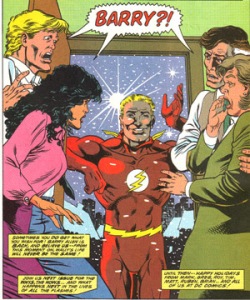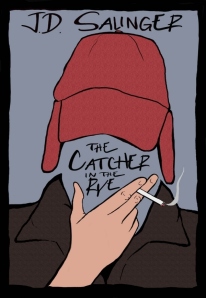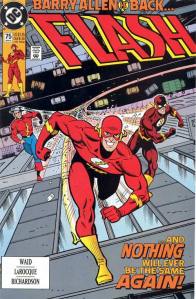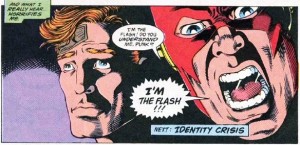During the month of September DC Comics will be doing a line wide crossover event affecting almost all of their superhero titles. If you’d like to skip this event but still need your DC fix NBC has you covered with DC’s Post Crisis Rebirth. In it we will explore the many important, influential and just plain rad titles that came out of DC Comics original line wide reboot. Our first entry will focus on Mark Waid’s Flash Arc The Return of Barry Allen.
When looking at DC Comics from the post Crisis era it’s impossible to not see their influence plastered across the medium today in multiple ways. The Frank Miller Year One/Dark Knight Rises/Alan Moore Watchmen/Swamp Thing influence is omnipresent almost everywhere you look while Morrison’s and Gaiman’s cerebral qualities to Doom Patrol/Animal Man/Sandman is the inception point for modern surrealism in comics. But what’s probably as influential if not more so is the everyman hero style that’s become a staple of modernizing superhero’s for the late 20th and early 21st century. Everyman superhero writing is essentially a way to write superhero’s that makes them relatable to the reader by using an internal dialouge that is meant to read like a casual conversation you’d have with a friend similar to JD Salinger’s influential Catcher In The Rye. This has become a hallmark of modern DC Comic and it has been for quite some time as you can see it in the best and most influential work of writers like Geoff Johns, James Robinson, Greg Rucka and Jeff Loeb while new kids on the block like Scott Snyder, Jeff Lemire, Greg Pak, Charles Soule Kyle Higgins and James Tynion IV have all utilized that narrative style for a lot of their most signifigant comic work at the publisher. Heck notable marvel writers like Matt Fraction, Kelly Sue DeConick, Rick Remender and Ales Kot all play with that writing style as well and even legend in his own right Ed Brubaker adopted it for his first DC work on Batman before developing his own narration style that we would see later on and thats in spite of being mentored by the Hernadez brothers. When I look back at the eptimology of this style, while you can clearly see the influence of pre crisis writing from Frank Miller and Alan Moore on the technique, it all really comes together on Mark Waid’s brilliant Flash run post Crisis Of Infinite Earths and the way he utilizes that as a conversation with both the readers and his predecessors on The Return Of Barry Allen arc is where that style truly comes into it’s own. So while Watchmen, The Dark Knight Returns, Year One, Doom Patrol, Sandman, Swamp Thing and Animal Man have all had a very clear and large influence on the way modern superhero comics are written Waid’s run on the Flash is at least as important as those above mentioned comics if not possibly more so in terms of it’s breath and scope of influence on modern comics.
 In terms of Post Crisis comics The Return Of Barry Allen was published about six years after the event but it is so tied into Crisis Of Infinite Earths that it’s impossible not to consider both comics with one another. Waid himself was an editor for many of the best post crisis comics as he came from Fantagraphics to oversee the such influential post Crisis comics like Doom Patrol, Action Comics, Legion Of Superheros and Wonder Woman before becoming a freelance comics writer of his own. He took over a Flash title in flux as the Flash of the pre crisis DC known as Barry Allen had sacrificed his life to save the universe in Crisis Of Infinite Earth only to be replaced by his former side kick/Kid Flash Wally West in the main line of titles. One of the fun parts about DC Comics is how their just below the headline group of hero’s like your Flash or Green Lanterns have always been replaced by new versions of the same hero and the legacy that those different versions have created within the comics history. This is especially apparent for The Flash who was one of the first to see have that replacement with Barry Allen taking over for the original Jay Garrick. Your favorite Flash says as much about you as it does the quality of the comics. I’m partial to Wally West for a number or reasons chiefly him being the Flash for some of my favorite comics in general including Waid’s Flash run in addition to Morrison and Waid’s JLA or Wolfman/Perez New Teen Titans as well as relating to
In terms of Post Crisis comics The Return Of Barry Allen was published about six years after the event but it is so tied into Crisis Of Infinite Earths that it’s impossible not to consider both comics with one another. Waid himself was an editor for many of the best post crisis comics as he came from Fantagraphics to oversee the such influential post Crisis comics like Doom Patrol, Action Comics, Legion Of Superheros and Wonder Woman before becoming a freelance comics writer of his own. He took over a Flash title in flux as the Flash of the pre crisis DC known as Barry Allen had sacrificed his life to save the universe in Crisis Of Infinite Earth only to be replaced by his former side kick/Kid Flash Wally West in the main line of titles. One of the fun parts about DC Comics is how their just below the headline group of hero’s like your Flash or Green Lanterns have always been replaced by new versions of the same hero and the legacy that those different versions have created within the comics history. This is especially apparent for The Flash who was one of the first to see have that replacement with Barry Allen taking over for the original Jay Garrick. Your favorite Flash says as much about you as it does the quality of the comics. I’m partial to Wally West for a number or reasons chiefly him being the Flash for some of my favorite comics in general including Waid’s Flash run in addition to Morrison and Waid’s JLA or Wolfman/Perez New Teen Titans as well as relating to him on a personal level where Wally comes from a metropolis in the Midwest called the Twin Cities like myself and is in a interracial marriage like I am now. That’s what makes him an interesting parallel for real life as he comes from a more traditional legacy of hero’s but also has his own very modern elements that reflects a lot of what I’ve experienced having grown up in the Midwest in the 90’s/2000’s where tradition and the changing reality of day to day life tend to approach each other head on. In the arc, what appears to be the actual Barry Allen comes back out of nowhere and essentially slowly begins to unravel the life of Wally West. This is also where the everyman speech becomes important because Waid’s story is as much a conversation with the reader as it is with comics of the past.
him on a personal level where Wally comes from a metropolis in the Midwest called the Twin Cities like myself and is in a interracial marriage like I am now. That’s what makes him an interesting parallel for real life as he comes from a more traditional legacy of hero’s but also has his own very modern elements that reflects a lot of what I’ve experienced having grown up in the Midwest in the 90’s/2000’s where tradition and the changing reality of day to day life tend to approach each other head on. In the arc, what appears to be the actual Barry Allen comes back out of nowhere and essentially slowly begins to unravel the life of Wally West. This is also where the everyman speech becomes important because Waid’s story is as much a conversation with the reader as it is with comics of the past.
In the story Wally West is directly narrating the action but unlike the Chris Claremont style of prose where that narration is used to point out the glaringly obvious in The Return Of Barry Allen it’s written as if it’s being told to a friend. It’s feels like Wally West is telling the reader the story and that’s important in this case because it’s a story about the relationship between different generations of superhero’s in comics. In effect West is telling the story to a group of readers that already know and have a relationship with Barry Allen and the story is about how that relationship affects the judgment of the protagonist inside the story. You can look at all that and see Waid himself comparing his own writing of DC legacy characters with those of the past. Waid’s knowledge and breath of influence from DC Comics golden and silver age is well documented as he’s been known to have memorized issue numbers and dates of release at random for various Justice League comics over the course of the titles very long existence and perhaps no modern writer has displayed his influence from those era’s as prominently in his writing as Waid has. But Waid isn’t just a golden age revivalist as his writing has always felt specifically modern in the way it synthesized those influences. Waid’s time on The Flash was one of his earliest writing assignment’s and you can see him wrestling with the weight of his past influences and the decades of stories that he grew up on with the character. It’s Waid talking to the reader about engaging with the legacy that he wants to live up to and it’s done in a manner that is both effortless, easy to understand and doesn’t require a metatextual reading of it as the story is strong enough in and of itself. But viewing through the lens of the author adds another dimension that makes for as powerful a statement on the post crisis DC universe as there is. As stated previously Waid’s Flash came well after Crisis but the arc is a direct result of what happened in Crisis Of Infinite Earths. It’s more of an answer after the fact as to what DC comics was after Crisis and it’s relationship to it’s past in that it was still informed and indebted to it but that past was part of an ever evolving narrative and this was Wally West and by extension’s Mark Waid’s time in that evolution. In the end the “Barry Allen” of the story is exposed as a fraud because that’s the only thing he could be. The past isn’t coming back just like Mark Waid wasn’t going to write in the Silver Age. All we have is now and while history will always inform our present we are the ones that dictate it’s context within the present. For Waid that meant shedding the baggage of Barry Allen on Wally West, his past influences and the pre crisis DC universe and for comics on the whole it meant not only a definitive Wally West story or piece of writing from Mark Waid but a strong example of how to use decades old characters in a modern context. So when you read a Charles Soule Swamp Thing comic or and issue of Fraction’s Hawkeye just know that a piece of it’s DNA is directly connected to Mark Waids time on The Flash & The Return Of Barry Allen and it’s influence on the medium. More then making Wally West The Flash it made superhero’s one of us and they wouldn’t be where they are today without that.



Great analysis on the writing style. I remember this arc well and could sympathize with Wally’s hope throughout the story that his mentor had returned from the dead. Brilliant of Waid to take us on this journey through Wally’s eyes.
Quite honestly back then when it first came out, I never paid attention to who wrote the story. No surprise to find out years later that Mark Waid did the scripting.
This is what is missing now when I read the new 52 stuff. No connection to the past and DC is being too ambiguous on what the history of this timeline is.
I disagree, depending on what titles you read; there’s too much connection to the past (Batman, GL, Legion of Superheroes). Other titles like Aquaman, WW, and Green Arrow found ways to honor the past without being beholden to it. I was listening to a podcast and one of the hosts was salty about Doomsday and “The Death of Superman” being referenced in a recent Johns issue. The past is in the New 52, for good and bad.
Thanks man glad you liked it
@Jeremy
This is why I love the multiverse concept. Everything that has ever happened in the DCU, still exists in it’s time and space. Somewhere. Although, existing as a hallucination of Morrison Batman is also pretty rad. 😉
Crisis of Infinite Earths, as fun as it was to read, really fucked DC in so many ways. With no multiverse, there was nowhere to put all the history that they wanted to do away with for the reboot of ’85. And simply ignoring it seems to really piss people off. The subsequent Zero Hour event tried to address and fix the contradictions in the timeline, but ended up creating new sets of problems. Then they tried to explain it away with the concept of hypertime, to no avail. Infinite Crisis most successfully solved some of the problems by reviving pre-crisis concepts.
To me, the New 52 and the reintroduction of the multiverse was the best possible move for DC. Before the New 52 relaunch, I read twice as many marvel books as DC. Now the opposite is true.
HOWEVER, I think you raise a very valid point in your assertion that there’s no REAL connection to the past. Basically writers/editors can pick and choose whatever they want to be canon, but as the God of my comic book collection, I decide for myself what has happened and I create my own continuity. The multiverse positively reinforces my perspective. Somewhere in the multiverse, Catwoman still started out as a prostitute like in Year One. Joker still shot Barbara. Hal still became Parallax.
It was just pure luck that I picked up Flash vol2 #62. The first Mark Waid issue on the book had an interesting cover to my preteen eyes and an interesting “born to run” subtitle also. Made me a Flash fan for life. I read quite a few of Waid’s hundred issue run and quite a few of Johns’ that directly follow it. For me the two runs don’t skip a beat; both great fun.
Thanks for reading man
I finished rereading this recently. It still holds up and has Waid’s trademark of taking the material seriously without necessarily being serious. What surprised me was how much was used in later Geoff Johns’ issues in how Zoom was used, and how he brought back Barry Allen for real. Waid’s figure prints will always be on the Flash I think.
Thanks for reading dude. Like u said this run seems like a very heavy influence on Johns
Great article, Patrick. It’s good to see some talk about older books on the site, especially during DC’s dreaded September event. I’m one of the people almost totally skipping all DC books this month.
While I don’t remember a great deal about Waid’s run on The Flash, it was the first time that I ever really picked the book up regularly, and it was a great run. Wally is my favourite Flash as well, like you, it was Wolfman and Perez’ New Teen Titans that got me involved with Wally. Barry was older and had been around for too long and never had the personality that Wally had. It’s the same as my preference for Kyle Rayner as Green Lantern over Hal Jordan.
While I stuck around with The Flash pretty much until Johns run finished it was never as good as Waid. And when Waid teamed with Mike Weiringo… Waid’s run of The Flash is definitely the book and the character’s high point. Gonna have to try and find the time to re-read these now.
Thanks for reading. New Teen Titan fo life
Mark Waid Flash is awesome. I have a lot of those old books signed by the man himself. Helluva nice guy.
Besides Rebirth, I haven’t read Johns Flash, so I can’t speak to the correlations. At the time, I was playing “catchup”, Johns was the darling of the industry and getting his print run was hard to come by in my area. This was before the digital comics revolution and eBay wanted ridiculous prices. Now might be a good time to discover. . .
Ebay/ the complete run of Johns on the Flash for about a dollar an issue. http://www.ebay.com/itm/THE-FLASH-164-246-Geoff-Johns-Complete-Iron-Heights-8-More-ANNUALS-NM-MINT-/351132052169?pt=US_Comic_Books&hash=item51c119eac9
I meant about 2 dollars an issue. Math!?
That’s cool about Waid. Sometimes when I read his blog writing I think he can come off as kind of a dick (although no doubt I do as well. Because I am 🙂 I always laugh when I think of this blog post he wrote about watching the last Superman movie in the theatre and standing up to yell @ the screen with his gf there because the scene with Superman & Zod pissed him off (you know which one if you’ve seen it) I just like picturing that happening @ a movie theatre in Indiana with everybody being like “uhhhh what???” not realizing that this guy yelling wrote parts of Superman comics that were appropriated into the film
Would have been awesome to be in that theater to see that.
@iroberts
Yeah, there’s been a long cooling off point and the availability of digital copies makes it the most convenient.
@Phess
Waid is dogmatically opinionated concerning superheroes. And I know exactly the scene you’re talking about. I wonder how Waid feels about Moore’s “Whatever Happened to the Man of Tomorrow”. I’m pretty sure it served as his inspiration for “Kingdom Come”.
Dogmatic is a very good way to put it. How do you feel that Whatever happened….influenced Kingdom Come? I never got that connection
Kingdom Come is Waid’s indictment of how dark superheroes and comic books in general had become post-crisis and into the 90s. Heroes killing crooks and villains killing any and everyone. Waid is very vocal in his disdain for violence for shock value and says heroes shouldn’t kill, but rather should set a good, if not righteous, example for people to aspire to.
Whatever Happened to the Man of Tomorrow is, to my knowledge, the last silver age Superman story before Byrne’s Man of Steel reboot. Whatever Happened to the Man of Tomorrow showcases all of Superman’s villains, most of whom were just nuisances before, like Bizarro, Toyman, prankster, Mxyzptlk, but had reappeared as vicious killers. Superman also becomes a shade darker himself when he kills Mr Mxyzptlk (I wonder if Waid stood up and yelled at the comic book 😉 ).
So when I say it served as inspiration, I surmise that he took books like whatever Happened, Year One, Killing Joke, Watchmen, DKR and pretty much everything coming out of Image in the early 90s and used it as motivation to write a story (Kingdom Come) about how superheroes and, to a lesser extent, villains should conduct themselves in comic books.
“Kingdom Come is Waid’s indictment of how dark superheroes and comic books in general had become post-crisis and into the 90s. Heroes killing crooks and villains killing any and everyone. Waid is very vocal in his disdain for violence for shock value and says heroes shouldn’t kill, but rather should set a good, if not righteous, example for people to aspire to” Interesting, I see where your coming from here but I’d assume Waid would be in the school of thought that comics “took the wrong lessons” from those books you mentioned.
Hahaha I know right. Epic. The best part is that he lives in (an I’m assuming watches movies in) middle america where like that shit is probably way more uncommon. I’m just picturing a theater full of nice Midwestern people that probably know a little bit but not a whole lot about superman at the climax of the movie just being like “What the hell is this?!?!?!”
Is it too late to comment? I’m glad Google led me here, because the premise is good, but the command of English is horrible. Commas are your friend, and the different between it’s and its is important, and gah! I stumbled over these things, every second or third sentence! B+ at best.
The fact of the matter is that commas are not necassary when you use the word “and”. It may be your preferrance to use commas in all of those situations but it is not an absolute rule. Frankly, I think that you are using too many commas and I’m a University graduate with honors (since grade school). English sminglish, God save the Queen and the rain in Spain falls mainly on the plane.
and may I add that this is the internet and not grammar school, and the following… Bah-weep-Graaaaagnah wheep ni ni bong!